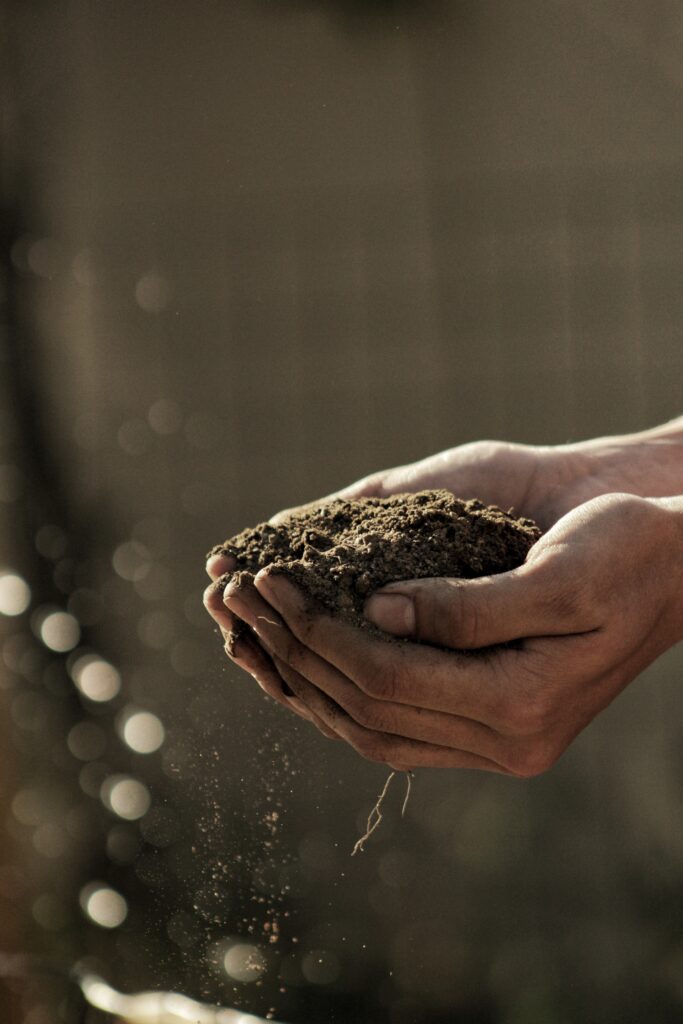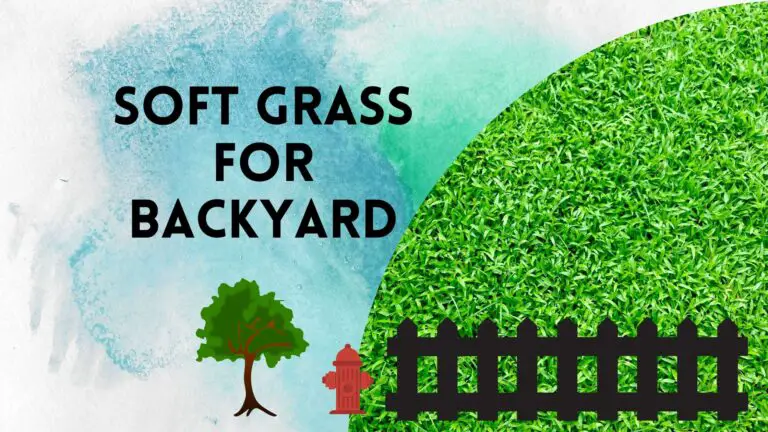What Is The Best Grass For Clay Soil?
When selecting grass seed for your lawn, various factors to consider. They comprise shade tolerance, drought resistance, cold and heat tolerance, and so forth. The sort of soil in your garden, though, is the most crucial of all.
Although clay soils are usually rich in nutrients, they tend to store more water than air, which causes grass to die.
Despite this, many plants thrive on clay soil, including a few lawn grass varieties. Furthermore, organic materials might be added for a better outcome.
So, what is the best grass for clay soil? Buffalo Grass, Bermuda Grass, Tall Fescue, Zoysia, Kentucky Bluegrass, Red Fescue, or Perennial Ryegrass are the best grass for clay soil, depending on your environment.
Because of their strong root systems that grow deep into the earth, these types thrive in compacted and heavy soil.

What Is Clay Soil?
So, what is clay soil, exactly? Clay soil is solid and heavy. It might be difficult for certain plants to establish good root systems because it is so compact.
While many people believe clay soil is devoid of beneficial properties, this is not the case. It is simply a matter of learning how to navigate this soil correctly.
Clay soil is very water-retentive. However, due to the absence of natural drainage, landlords regularly overwater their lawns, causing root rot and other issues. Clay soil is also nutrient-dense, with high calcium, magnesium, and potassium levels.
Clay soil can be a vivid red hue in some parts of the United States, but it can also be a variety of brown colors.
Best Grass For Clay Soil
When your lawn’s grass isn’t growing thick and lush, it might be due to many factors ranging from low nutrition to planting the lawn in the improper sort of soil.
Clay soil may identify by slow growth, yellowing grass, and pools of water in the yard. Here are several grass types that thrive on clay:
1. Tall Fescue

Tall fescue is the first grass that thrives on clay soil. It thrives on clay soil, especially if you’re seeking cool-season grass. Tall fescue may be grown in either partial shade or full sun.
This type of grass produces a coarse-textured green with a range of colors. Turf-type tall fescue grasses and mini turf-type grasses are among the varieties.
Tall fescue thrives on clay soil because its roots reach deep into the earth, unlike other cool-season grasses. And it thrives best in clay soils.
Also, it is not suitable for the deep south. Still, it can be grown across the majority of the United States, so if you need cool-season grass that thrives in clay soil, tall fescue is a fantastic choice.
2. Bermuda Grass

Because of its fibrous root structure of deep rhizomes, Bermuda grass is an excellent grass to grow on clay soils. It’s ideally suited to extracting water and precious oxygen between the tiny particles of clay soil.
Bermuda grass has a wide range of roots that grow to a depth of at least 6 inches. Bermuda grass goes dormant when the temperatures drop at the start of winter, only to reappear in the spring.
This grass may be grown from seed, germinating quickly (7-14 days). Water your lawn weekly with 1 to 1.5 inches of water to help Bermuda grass grow stronger and more resistant to drought, bugs, and weeds.
3. Buffalo Grass
The Buffalo grass, also known as Buchloe Dachtyloides, is another grass type to consider while looking for the best grass for clay soil. This grass is a good choice for people who seek grass that can withstand droughts and low water conditions on clay soil.
Buffalo grass is an excellent alternative for people who live in very hot, dry regions. It is a warm-season grass that tolerates clay. Buffalo grass also requires less watering, which is fantastic news.
It’s essential to keep in mind, though, that buffalo grass falls dormant from November to January.
Buffalo grass begins to become green in March and April. It’s an excellent time to grow buffalo grass when the temperature outdoors is over 60 degrees Fahrenheit.
Buffalo grass may not provide you with the best lawn all year, but it will have many advantages. It thrives on clay soil and thrives in hot climes.
4. Zoysia

The warm-season turfgrass Zoysia thrives on clay soil. Its roots form a dense, thick structure that extends about 2 inches into the earth. As a result, they’re well-suited to taking water, nutrients, and oxygen from clay soil’s top layers.
Another advantage of planting a zoysia lawn in southern areas with red, heavy soil is that the grass seed starts growing and matures into heat- and drought-resistant turf.
It’s also a great grass for winter lawns, and it’s hardy enough to grow in USDA zones 6-9. When properly managed, zoysia grass develops into a thick, high-quality lawn.
This warm-season grass thrives in the United States’ Zone 3. This grass takes longer to grow than other lawn grasses.
5. Perennial Ryegrass

Perennial ryegrass is the last type of cool-weather grass we’ll check.
This grass is well-known for germinating fast in comparison to other grasses. Perennial ryegrass is typically included in mixed-grass seed bags because it provides shade for other cool-weather grasses as they grow.
Because of its strong roots and the fact that it is a highly resilient and low-maintenance grass, it thrives on clay.
The sole disadvantage of this grass is that it does not spread by rhizomes or stolons like other grasses. Thus it would have to be re-seeded in patchy or sparse places.
Best Cool-Season Grass For Clay Soil
If you reside in a suitable location for cool-season grass and you have clay soil, don’t panic. Many types can thrive in clay soil.
Tall fescue is a cool-season grass that I would suggest as the best grass for clay soil.
The primary reason I suggest tall fescue is that it has a long and powerful root system. The root system must be robust enough to deal with the complex conditions that clay soil may give, such as the fact that it is very thick soil.
Tall fescue thrives in difficult situations such as drought and prolonged periods of extreme heat.
Tall fescue’s root structure will make it nearly impregnable once it establishes, and it’ll produce a stunning lawn that will be the envy of your community.
Best Warm-Season Grass For Clay Soil
Clay soil under your grass may make growing a beautiful green lawn more complex. Half the battle ensures you choose the ideal grass species for the circumstances clay soil will give.
Zoysia grass is a warm-season grass that I would suggest as the best grass for clay soil. I chose zoysia because it has a robust root structure, essential when working with clay soil.
Clay soil is a thick form of soil, which contributes to the numerous obstacles you may have while establishing a grass lawn on it.
Zoysia is a fantastic choice for clay soil since the root system can thrive in the thick circumstances of clay soil.
It might be tough to get fresh grass started, but you shouldn’t have too much trouble creating a lovely lawn once it starts going.
How To Prepare Clay Soil For Grass?
It may be complex to get new grass to germinate, but you should have no problem growing a beautiful lawn once it does.
The good news is that there are many organic methods for improving clay soil that doesn’t need a lot of effort or money:
• Leaves: Spread a good number of green and brown leaves onto your clay soil with a portable leaf picker-upper to aid decomposition. Leaves promote the growth of beneficial bacteria and keep the soil wet.
• Grass Clippings: Excellent for fresh grass as well as an established lawn. They naturally give additional nitrogen and potassium when spread over bare clay soil. Both of these minerals are essential for healthy, luxuriant development and long-term preservation.
• Compost: Compost created at home is already high in the nutrients that a healthy grass needs. It also helps to prevent clay soil from drying up by improving drainage.
• Starter Fertilizer: Using a starter fertilizer to boost the quality of new grass growth is advised.
It’s a good idea to complete your clay soil with topsoil once you’ve applied organic matter. 2 to 5 inches of high-quality topsoil should be applied to the area.
It will dramatically increase the grass’s growth rate and guarantee that it receives all of the nutrients it requires to stay healthy and germinate.
How To Grow Grass In Clay Soil?
You now know which grass varieties are ideal for growing in clay soil, but there are a few more things you can do to improve the lushness of your lawn, in addition to choosing the best grass kind.
1. Dethatch
If you’re ripping up your lawn to make room for a new one, it’s simple to accomplish. Additionally, you may utilize the thatch not taken with the grass as other organic matter.
When it comes to dethatching a lawn that you wish to retain, use a motorized dethatcher or a thatch rake twice.
After that, add the thatch to the compost pile you’ll be using to enrich your soil.
2. Fix Your Ph
The first step is to figure out how much alkalinity your soil has. The simplest method is to use a soil tester.
This inexpensive sensor may measure the amount of sunshine, moisture, and pH in the soil. Place it in several locations across your garden and average the results.
The ideal pH level for the soil in your lawn is 6.5. Anything over that is alkaline, and anything below that is acidic. Because clay soil is generally always alkaline, you may need to apply powdered sulfur to correct the problem.
3. Add Organic Material
To disintegrate your clay soil, you need now add some organic matter.
Manure, topsoil, and compost are all excellent supplements for clay soil. Distribute the stuff on top of your grass, and it will take care of the rest.
Combine it with the upper layer of your soil with a garden rake for best results.
How Can Aeration Help Clay Soil Grass?
Aeration of the lawn is a procedure that includes making small yet deep holes in the soil. Essential ingredients, oxygen, and water may reach grass and plant roots through these openings.
Aeration also helps to remove compacted soil (have you ever noticed how grass struggles to grow near walkways where people walk all the time? The dirt has been compressed by foot movement).
Aerating your lawn can assist with the issues that clay soil can cause, mainly because clay soil is inherently compact and thick.
As a result, nutritional shortages and root infections can develop, which is why many clay-based lawns fail to thrive.
Ways To Aerate Your Clay Soil
- You can puncture tiny holes in one of your grass’s margins with an aerating fork, or you can wear lawn aerating shoes.
- Every other year, hire a professional core aerator to bring your lawn a breath of fresh air.
- To soften compacted clay soil, use a liquid treatment.
- Alternatively, you may engage a landscaping service to do it for you.
How to Water Grass In Clay Soil?
It’s crucial to remember that grass grown in clay soil requires less watering than grass planted in sandy soil. Clay soil holds a lot of water. Therefore it’s essential to check the moisture level before watering.
As a result, if a person watering on clay soil isn’t attentive, the grassroots may be drowned.
Sticking a screwdriver into the soil down to around six inches is one method I’ve seen advocated for determining how much water is in an individual’s clay soil. After that, remove the screwdriver. If the screwdriver’s tip is dry when you remove it, the soil is also dry and needs to be watered.
I usually dig my finger into the ground. I let it alone if it’s soft and wet. However, if the land is dry and hard, it must be watered. Whatever method you use, be careful not to overwater.
Keep in mind that firmly compacted clay makes it difficult for water to leech and drain. A newly formed lawn might be drowned if you overwater it repeatedly. Give it only what it requires.
Conclusion
Don’t accept the claim that you could not grow a healthy, attractive lawn with clay soil.
I had one of the worst red clay soil you can think of. Still, with some cautious planning and preparation, I’ve been ready to surpass the clay soil issues and, for the most part, grow an incredible carpet of grass in my yard.
Your climate will play a role in determining which grass is ideal for clay soil. However, preparing the soil before seeding or planting your grass will offer it the best chance of thriving.







